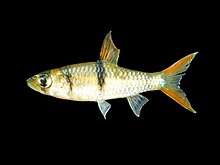Hampala macrolepidota
| Hampala macrolepidota | |
|---|---|
 | |
| Scientific classification | |
| Kingdom: | Animalia |
| Phylum: | Chordata |
| Class: | Actinopterygii |
| Order: | Cypriniformes |
| Family: | Cyprinidae |
| Genus: | Hampala |
| Species: | H. macrolepidota |
| Binomial name | |
| Hampala macrolepidota Kuhl & van Hasselt, 1823 | |
| Synonyms | |
| |
The hampala barb (Hampala macrolepidota) is a relatively large southeast Asian species of cyprinid from the Mekong and Chao Phraya basins, as well as Peninsular Malaysia and the Greater Sundas (Borneo, Java and Sumatra).[1][2] It prefers running rivers and streams, but can be seen in most freshwater habitats except torrents, small creeks and shallow swamps.[2] This predatory species reaches up to 70 cm (2.3 ft) in length and it is common at half that size.[2]
As food
This fish is one of the fish species that has been used as food in Southeast Asia since ancient times.[3]
Although it is an important food fish, it remains abundant in at least parts of its range, resulting in a Least Concern rating by the IUCN.[1]
References
| Wikimedia Commons has media related to Hampala macrolepidota. |
| Wikispecies has information related to Hampala macrolepidota |
- 1 2 3 Allen, D.J. (2013). "Hampala macrolepidota". IUCN Red List of Threatened Species. Version 2014.3. International Union for Conservation of Nature. Retrieved 14 March 2015.
- 1 2 3 Froese, Rainer and Pauly, Daniel, eds. (2015). "Hampala macrolepidota" in FishBase. March 2015 version.
- ↑ Charles Higham, A. Kijnga ed. The Origins of the Civilization of Angkor: Volume VI The Iron Age. page 43. IV 'The Fish Remains'
This article is issued from
Wikipedia.
The text is licensed under Creative Commons - Attribution - Sharealike.
Additional terms may apply for the media files.
